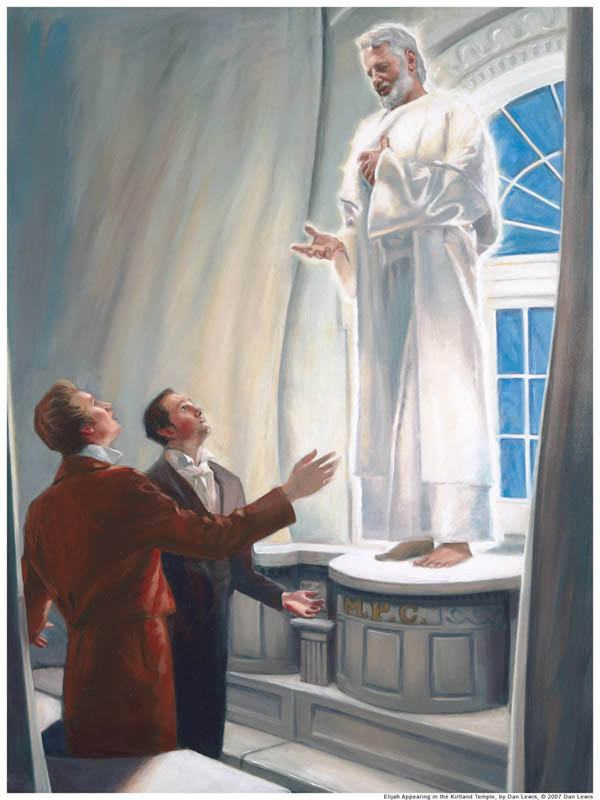In Ohio, the Mormons were building their community in Kirtland, a small community southeast of Cleveland. May of 1833, while the Mormons in Missouri were being driven from their homes, Joseph Smith received a revelation commanding the Mormons to build a House of the Lord in Kirtland to be “dedicated unto the Lord for the work of the presidency.” The extreme poverty of the Mormons, many of whom had been driven from their lands without compensation, made this a difficult undertaking, and for a month, nothing happened. On June 1, another revelation was received chastening Joseph Smith and the Mormons for not starting the building of the new Mormon temple and promising them help in completing it. Immediately, the preparatory trenches were dug with Hyrum Smith, the Prophet’s prophet, being the first to dig. In July, the cornerstones were laid, and the construction continued until early 1836. Interestingly, while the Lord in His revelations referred to this building as His House, it is never called a temple in the revelations. This is important, because the Kirtland House of the Lord differed from later Mormon temples in design, purpose, and use. However, the revelations repeatedly refer to the proposed holy sites in Jackson County and later in Nauvoo as Mormon Temples as well as Houses of the Lord.
The Kirtland Temple included two large meeting halls, an upper and lower one. The uppermost floor contained offices and smaller meeting rooms used for the Presidency of the Mormon Church and later for the School of the Prophets, which trained some of the first Mormon missionaries. The large meeting halls were used as chapels and classrooms and could be divided into smaller rooms by large curtains which hung from the ceilings. The purpose of this temple was not to house ordinances and ceremonies like later Mormon temples, but to provide a place for the education and edification of the Mormons, to try their faith through sacrifice, and to provide a sanctuary where Jesus Christ could appear to His people.
This first Mormon temple was built after much hardship and required some of the greatest sacrifice in Mormon history. Construction was slowed by persecution, and some members described working with a trowel in one hand and gun for protection in the other hand. Men sacrificed time to work on the building and to procure materials, while the women sewed curtains and clothing. Many women later donated their glassware to be mixed with the external plaster to give the building a shimmering glaze.
 The Kirtland Temple was dedicated on March 27, 1836. The 1,000 gathered Mormons, the maximum who could fit inside, sang hymns, listened to sermons on sacrifice and the House of the Lord, and listened as Joseph Smith read the dedicatory prayer he had received by revelation, which is now recorded as Doctrine and Covenants 109. They also instituted the “Hosanna” shout as a form of praise to the Lord. Many of those present reported seeing visions of angels and of hearing a mighty rushing of wind and seeing tongues of fire as on the day of Pentecost. This manifestation came as a result of the early Mormons’ great faith and sacrifice. The Kirtland Temple provided a place for religious education in the form of the School of the Prophets and for many important revelations. It was in the temple that the first revelations regarding salvation for the dead, later expanded in Nauvoo, were received. On April 3, 1836, Jesus Christ himself appeared in the temple to Joseph Smith and Oliver Cowdery. He approved of the sacrifice of his people and accepted the House (Doctrine and Covenants 110:7). Then Joseph and Oliver saw Moses, Elias, and Elijah, each of whom restored certain Priesthood keys, or authority, over the gathering of Israel, the Gospel of Abraham, and the Sealing power of the Priesthood (see Doctrine and Covenants 110). These Priesthood keys are necessary to build and operate the later Mormon temples with all their ceremonies and covenants.
The Kirtland Temple was dedicated on March 27, 1836. The 1,000 gathered Mormons, the maximum who could fit inside, sang hymns, listened to sermons on sacrifice and the House of the Lord, and listened as Joseph Smith read the dedicatory prayer he had received by revelation, which is now recorded as Doctrine and Covenants 109. They also instituted the “Hosanna” shout as a form of praise to the Lord. Many of those present reported seeing visions of angels and of hearing a mighty rushing of wind and seeing tongues of fire as on the day of Pentecost. This manifestation came as a result of the early Mormons’ great faith and sacrifice. The Kirtland Temple provided a place for religious education in the form of the School of the Prophets and for many important revelations. It was in the temple that the first revelations regarding salvation for the dead, later expanded in Nauvoo, were received. On April 3, 1836, Jesus Christ himself appeared in the temple to Joseph Smith and Oliver Cowdery. He approved of the sacrifice of his people and accepted the House (Doctrine and Covenants 110:7). Then Joseph and Oliver saw Moses, Elias, and Elijah, each of whom restored certain Priesthood keys, or authority, over the gathering of Israel, the Gospel of Abraham, and the Sealing power of the Priesthood (see Doctrine and Covenants 110). These Priesthood keys are necessary to build and operate the later Mormon temples with all their ceremonies and covenants.
Within a couple of years, the Mormons were forced to abandon Kirtland, as persecution grew too severe. They moved to Missouri in 1838 and to Nauvoo in 1839. They abandoned their beautiful House of the Lord and all the sacrifice it had required, knowing that greater things lay ahead.
About Anita Stansfield
Anita Stansfield began writing at the age of sixteen, and her first novel was published sixteen years later. For more than fifteen years she has been the number-one best-selling author of women’s fiction in the LDS market. Her novels range from historical to contemporary and cover a wide gamut of social and emotional issues that explore the human experience through memorable characters and unpredictable plots. She has received many awards, including a special award for pioneering new ground in LDS fiction, the Lifetime Achievement Award from the Whitney Academy for LDS Literature, and also a Lifetime Achievement Award from her publisher, Covenant Communications. She has fifty-six published books. Anita is the mother of five, and has three grandchildren.


 Watch a video about the restoration of the gospel on lds.org
Watch a video about the restoration of the gospel on lds.org